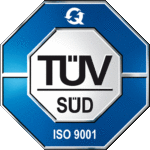Current European legislation is divided into 3 types:
✔ Type A standards (known as pivotal safety standards), offer fundamental concepts, design principles, and general aspects applicable to all machinery.
✔ Type B standards (also referred to as generic safety standards), address specific safety aspects or types of protective measures that are applicable across a broad spectrum of machinery:
✔ Type B1 standards on particular aspects of safety (e.g. safety distances, surface temperature, noise);
✔ Type B2 standards on means of protection (e.g. two-hand controls, interlocking devices, pressure-sensitive devices, guards);
✔ Type C standards (safety standards for machine categories) dealing with detailed safety requirements for a particular machine or group of machines.
Below is a list of standards that may be of interest to you, particularly if you are a product manufacturer.
Standard EN ISO 20607:2019 - Drafting of Instruction Manual
The technical standard EN ISO 20607:2019, harmonised in compliance with the Machinery Directive 2006/42/EC since 02/04/20, serves as the guiding reference for the formulation of the Instruction, Use, and Maintenance Manual for products falling within the purview of the Machinery Directive.
EN ISO 20607:2019 outlines the requisites governing the composition of an Instruction Manual intended for machinery and installations. It offers supplementary specifications beyond those outlined in the technical standard EN ISO 12100:2020 concerning the preparation of Instructions.
Covering a wide range of topics, including fundamental principles and informational essentials to the core components of the instruction manual, encompassing presentation, formatting, and guidance for instructional writing, standard EN ISO 20607:2019 stands as an indispensable resource for manufacturers of machinery and installations, ensuring presumptive conformity with the Machinery Directive.
ISO 3864 Standard – Graphical Symbols – Safety Colours and Safety Signs
ISO 3864 stipulates safety signs for implementation in accident prevention, fire protection, health hazard communication, and emergency evacuation procedures.
The standard specifies the master copies of safety signs, which can be scaled down or enlarged for replication and application, while also specifying the shape and colour of each safety sign. It is applicable to all locations where matters of personal safety are pertinent, with the exception of transportation routes, as they are governed by distinct regulations.
It is divided into four parts, each focusing on specific aspects of safety signs:
- ISO 3864-1:2011 - General requirements for the design and use of safety signs
- ISO 3864-2:2016 - Requirements for safety signs for the working environment
- ISO 3864-3:2012 - Requirements for safety signs for evacuation routes
- ISO 3864-4:2011 - Requirements for safety signs for fire-fighting equipment
Standard UNI ISO 7010:2023 – Graphical Symbols – Colours and Safety Signs – Recorded Safety Signs
The standard prescribes the recognised safety signs and symbols that can be used in accident prevention, in the fields of fire protection, information on health hazards and emergency evacuations, and conduct obligations.
For the shape and colour of the signs, please refer to ISO 3864 standard.
Symbology relating to rail, road, river, sea and air traffic are excluded from this standard
This standard is the seventh amendment to the international standard ISO 7010:2019/Amd 7:2023, which entered into force on 29 June 2023, and replaces all previous versions.
Standard UNI ISO 7000:2019 - Graphical symbols used on equipment - Registered symbols
This standard is intended to establish a set of graphic designs that fulfil the criteria for depicting visual symbols utilised to convey information irrespective of language barriers.
The standard provides a synoptic table of graphical symbols suitable for placement on equipment or its components, making it easier for individuals to utilise and operate the equipment.
Standard UNI/TS 11192:2018 - Criteria for classification
This standard was approved in September 2006 and classifies the different types of documents accompanying products. Manuals, guides or other information intended for users.
The classification examines an array of documents required, considering the end user's needs and the intricacy of the asset in question.
Standard UNI 10653:2003 - Technical documentation - Quality of technical product documentation
The UNI 10653 standard defines the criteria for the realisation of quality information that the manufacturer is obliged to provide to product users, through technical product documentation.
This standard is applicable to all technical product documentation essential for the transmission of information from the manufacturer to the user.
It does not apply to:
the technical documentation necessary for the realisation of the product (e.g.: drawings, production and control plans);
to technical documentation prior to the delivery of the product (offer, quotation, etc.);
to advertising-type messages.
Standard UNI EN ISO 10893 – Instructions for use – Articulation and exposition of content
This standard has meticulously considered both obligatory and discretionary provisions entailed in the production of technical documentation, accounting for the diverse requisites across various product sectors and the contemporary advancements in communication modalities.
The UNI 10893 standard applies to the technical information accompanying the product in the phases of:
installation;
use;
operation;
maintenance;
education/training
decommissioning.
The technical product information covered by this standard is addressed to the recipients defined by UNI 10653.
This standard does not extend to the content of technical product information. For guidance on this matter, reference should be made to prevailing legislative regulations and pertinent UNI standards.
Standard UNI 11083:2003 - Technical documentation - Guidelines for the preparation of documents useful for education and training activities for the use of equipment
The standard outlines guidelines for training instructions intended for inclusion in the technical documentation accompanying a product. These instructions, specified by the manufacturer, detail the operations necessary for the product's utilisation, spanning from installation to disposal.
This standard specifies the essential documents requisite for education and training pertaining to the professional use of goods, while also offering guidance on the content to be included within each document.
The training referred to includes the following aspects:
Instruction, i.e. transmission/acquisition of skills/skills
Training, i.e. guided development of skills/skills
Behaviour, i.e. integrated use of knowledge and skills acquired through experience
Standard UNI EN ISO 12100:2010 – Safety of machinery – General principles for design – Risk assessment and risk reduction
This standard is a type A, fundamental safety standard.
This standard specifies the technical principles necessary for the design and simultaneous attainment of safety in machinery design.
This standard does not deal with damage to domestic animals, property or the environment.
Section 6 of this standard elucidates concepts and requisites pertaining to the provision of technical documentation aimed at ensuring the safety of machine operators.
6. INFORMATION FOR USE
6.1 General requirements
6.2 Information location and nature
6.3 Signs and warning devices
6.4 Markings, signs (pictograms), written warnings
6.5 Accompanying documentation (in particular the instruction manual)
IEC Standard IEEE 82079–1:2019 – Preparation of instructions – Structure, content and presentations
This standard published in May 2019 cancels and replaces the previous edition IEC 82079–1:2012.
This was a revision that provided, among other things, the following:
1) a reorganisation of the standard structure so that it would be easier to find the information
2) the incorporation of the generic term “Information for use” as a synonymous alternative for “Instructions for use”.
3) enhanced significance and comprehensiveness attributed to the phase of preparing information for use.
4) given more completeness to the necessary professional competences
g) given more consideration to the instructions for self-assembled products and complex systems.
The objective of this Standard is to delineate the overarching principles and meticulous requirements governing the design and composition of comprehensive and indispensable operating instructions intended for users of various product categories.
This section is addressed to all parties involved in the preparation of operating instructions, e.g:
Suppliers, technical writers, technical illustrators, software designers, translators or others engaged in the conception and drafting of such operating instructions.
STANDARD UNI 11483:2021 – Non–regulated professional activities – Professional communication – Requirements of knowledge, skills and autonomy and responsibility
After years during which the role of the technical writer remained unrecognised, and consequently, the related professionalism went unacknowledged, we have now witnessed the emergence of a technical standard that acknowledges the requisite knowledge, skills, and autonomy of this increasingly vital figure within the industrial landscape.
The UNI 11483 standard, released in September 2021, aims to delineate the requirements for the role of the technical communicator, thereby seeking to regulate the characteristics of this multidisciplinary figure that is progressively assuming a strategic role within companies.
This new UNI standard identifies five areas of reference and their corresponding specialised profiles, defining both the common tasks shared among all professional profiles and the specific responsibilities unique to each specialised role.
The five areas are:
• public and institutional communication
• corporate communication
• technical communication
• political communication
• social communication for the third sector.
The aforementioned five areas are further subdivided based on criteria of autonomy and responsibility to delineate competencies within each category:
• Junior (a neophyte approach to the world of professional communication),
• Expert (a professional with sector-specific skills and experience)
• Senior (the professional figure with responsibility who governs the art of communication).




